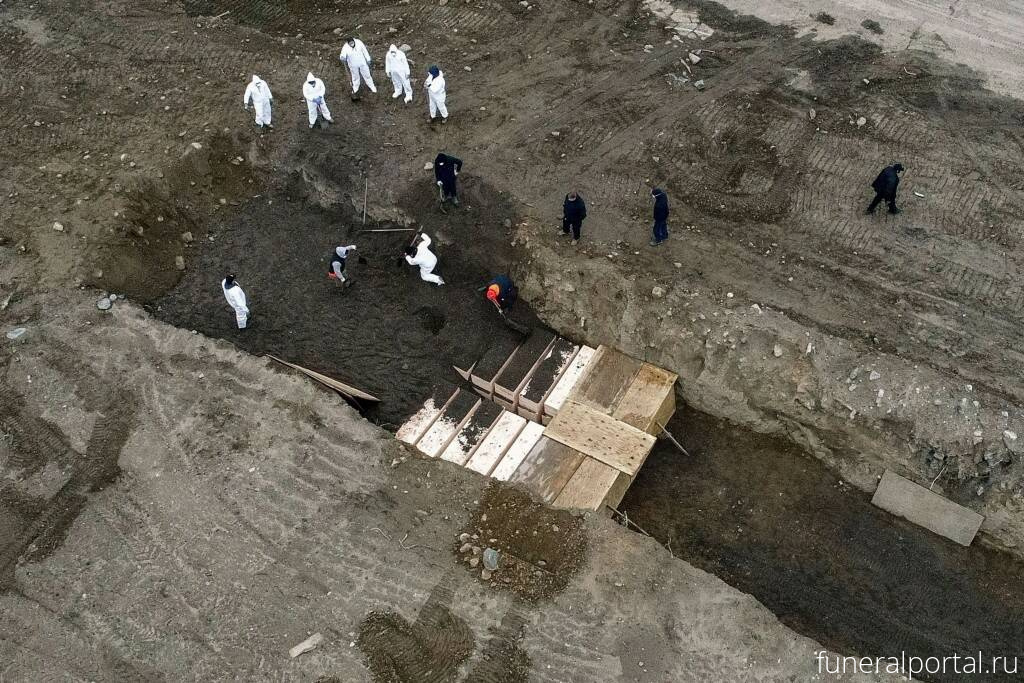By Mary Jordan

Workers wearing personal protective equipment bury bodies in a trench on Hart Island in the Bronx on April 9, 2020, during the first wave of the coronavirus pandemic. (John Minchillo/AP)
NEW YORK — Valerie Griffith’s final journey began on a battered ferry, a floating hearse bound for a most unusual island.
Nobody lives on Hart Island, a scruffy one-mile slice of land in Long Island Sound that New York’s tabloids call “Forgotten Island,” “Haunted Island” and “Isle of Tears.”
For 150 years, it’s been known as the place where the city buries its penniless — not art collectors like Griffith.
But on Dec. 7, 2020, Griffith’s coffin arrived at Hart Island’s dock and was loaded onto a truck for a quick drive to a trench the size of a tennis court. There, on a cold and wet morning, gravediggers lowered her simple wooden coffin into the muddy ground. No relative or friend was present and there was no mention of her remarkable life: how the English-born Griffith had helped the U.S. military during World War II, exposed antisemitism in the United States and married an American spy.
Griffith was simply No. 14 in plot No. 414.
Into the same mass grave, workers stacked 136 more coffins, three deep.
“I’m very surprised she ended up there,” said Pascal Imperato, a former New York City health commissioner who had spoken several times with Griffith and shared her interest in African art. “Valerie Griffith and her husband lived well. These are not poor people.”
But Hart Island, where New York City has buried more than 1 million people since 1869, is undergoing the biggest changes in its history. The city’s Department of Correction, which ran the burial ground like a penal colony for more than a century, relinquished control last year, and inmates no longer dig the graves. Millions of tax dollars are being spent to tame wild brush and demolish crumbling buildings.

Harder to see is the most significant change of all: a growing diversity of the people being buried here.
“It’s a wider mix of people,” said Melinda Hunt, who has spent years documenting the island and those buried on it. Hunt, the founder of the nonprofit Hart Island Project, said many families felt “shame” about its association with prisons, but light is coming to this “dark place.”
Along with Griffith, among those interred there recently are a professional ballet dancer, a nurse, a software engineer, a scuba instructor and an acclaimed musical composer.
New York City’s Hart Island is the nation’s largest public cemetery, but cities and towns across the country also run these potter’s fields, and many of them, similarly, are no longer just for the poor.
Several factors are driving the national shift, including a backlash against the steep cost of burials. Some people who can afford a private burial are refusing to pay for it. When police call a relative to inform them that their brother, mother or some other family member has died and to give them details of how to make funeral arrangements, many relatives do nothing. Some can’t afford burial costs that can easily reach $10,000.
Americans’ dramatic drop in religious affiliation means less interest in established rituals of churches and synagogues that mark milestones, including death. Today, many people don’t want the kind of funeral their parents and grandparents had.
And notably, the growing economic and social diversity of those interred in taxpayer-owned cemeteries comes amid spiking numbers of bodies that no one ever comes to bury. While no national count exists, a Washington Post investigation found that thousands of bodies go unclaimed every year.
When relatives of a dead person walk away, they force local authorities to make arrangements for the body left in the morgue. Medical examiners noticed a steady rise in the unclaimed beginning in 2009, during the Great Recession, and a surge in 2020, when the coronavirus pandemic hit.
“It’s one of the biggest issues we see — abandoned bodies. It’s almost an epidemic,” said Poul Lemasters, general counsel of the International Cemetery, Cremation and Funeral Association.
Local officials who deal directly with the unclaimed, including Meredith Buck, the coroner in Bucks County, Pa., said people who end up this way are not all destitute.
“Some of these people owned a home,” said Buck. “But nobody really tells the police or the coroner, ‘Hey, I think this person has a bank account.’ ”
In New York City, the unclaimed typically wind up on the ferry to Hart Island.
In 2020, that boat was grimly busy. It carried 2,600 coffins — three times as many as the year before.
The body of Valerie Griffith was in one of them.

A penthouse life
Three weeks before her quick, anonymous interment, Griffith had died in her Manhattan penthouse. Cardiac arrest was her official cause of death. She was 101.
Her life story — reconstructed from interviews, U.S. immigration records, declassified FBI documents, university archives and a 12-page job application she once filled out — started thousands of miles from Hart Island.
Born Valerie June Courtenay in England in 1919, she first worked as a “kennel maid,” a caretaker of dogs. But when Germany began bombing London in World War II, she studied German, Italian and French, and those skills helped land her a secretarial job at the U.S. Embassy in London that often got her in the room with Averell Harriman and other top U.S. diplomats.
An avid reader and aspiring journalist, she wrote radio scripts for U.S. soldiers. She also sent European dispatches to the New York Herald Tribune when John Steinbeck, already a sensation for his bestseller “The Grapes of Wrath,” was the paper’s war correspondent based in London.
Along the way, she met Sanford Griffith, an older, divorced man born in Oregon who had a curious array of jobs: U.S. military interrogator with fluency in five languages, stockbroker, professor and correspondent for the Wall Street Journal. He also was a spy working for British intelligence.

Coming to America
When she was 34 and he was 61, they married in 1954 in a Northern Virginia courthouse. Six weeks earlier, Griffith had arrived in New York City aboard a transatlantic ocean liner with two swimming pools and an art deco dining room covered in gold leaf.
“The couple are well known in diplomatic circles in America and Europe,” reported a 1954 article in the very local Sussex Agricultural Express in England. They went to Canada and Cuba for their honeymoon.

A newspaper clipping from the Washington Evening Star in 1957. In an incident that year, Valerie Griffith successfully booked into the Homestead resort in Virginia at the same time a Jewish woman with the last name Kaplan was told there were no rooms. (The Washington Star)
The horror of the Holocaust bonded the Griffiths. Both fought against antisemitism in the United States. In a widely reported incident in 1957, Valerie successfully booked into the Homestead resort in Virginia at the same time a Jewish woman with the last name Kaplan was told there were no rooms. The Anti-Defamation League, where Sanford Griffith worked, then filed a formal complaint.
In the 1960s, the Griffiths rented a penthouse apartment in the Shenandoah, a 74-unit building in the heart of Greenwich Village; they also owned a house in Middletown, N.Y., a two-hour drive away in the Hudson Valley. The couple traveled often to Africa and brought back hundreds of wooden and bronze art objects.
Then, in 1974, Valerie’s life shattered.
While she was making tea and her husband was reading the Sunday newspaper, Sanford Griffith died of a heart attack.
In shock, Valerie, then 55, called Brenda McCooey, Sanford’s daughter from his first marriage.
“ ‘I don’t know what to do now,’ ” her stepdaughter recalled Valerie saying. “She was in shock.”

McCooey said her father was not religious, and that when people in her family died, they were cremated, “instead of wasting money on funerals and flowers.”
McCooey described Valerie as quiet and the opposite of her gregarious father, a man who would suddenly turn a picnic into a skinny-dipping outing. “That 1974 phone call was the last time we ever spoke.”
After her husband died, Griffith gave lectures on African art at the New School in Manhattan, but she spent much of her time alone. She had been an only child, and had no children of her own. Her husband had been the organizer of their trips and dinners, and without him, her social life shrank.
She loved history, as she said on a 1949 job application for UNESCO. She grew up in a slower and more formal world. She often wore a tweed suit just to check for a letter in her building’s mailroom. In the 1980s, fast money on Wall Street sent rents soaring. Her penthouse was rent-controlled, but young stock traders were paying 10 times as much as she did.
Historian Thomas Mahl talked to Griffith in the 1990s for his book about British covert operations in the United States during World War II. Declassified documents and Mahl’s research showed how Sanford Griffith, on behalf of the British government, used fake public opinion polls and other deceptive propaganda to push Congress to join the war against Adolf Hitler.
Griffith spoke to Mahl for hours and told him unexpectedly intimate details, including that she had once been pregnant but lost the baby.
“I got the feeling she had no one else to talk to,” Mahl said.
Griffith gave others the impression she was not interested in talking to them, according to her stepdaughter and many neighbors. The Post spoke with two dozen residents in her building who had never said more than hello to the elderly woman in Apt. 15A. They knew little more than that she was about 5 foot 4 inches tall and spoke with a British accent. They didn’t know, for example, that she had worked with the U.S. military in France to create the famous cemetery at Normandy, a moving memorial to Americans who died overseas that is visited by 1 million people a year.

“She avoided people,” said Alfred Drapala, 92, a neighbor in Middletown who for years would see Griffith planting flowers in her garden. If he walked near her, she seemed to withdraw and didn’t say hello, he said. When he heard about her fascinating life and lonely burial, he said, “It’s very sad.” Drapala said he would have enjoyed talking to her about the war. He was living in his native Poland when German troops came to his town in 1939, a day he recalls vividly.
Another Middletown neighbor, Patricia Corn, lived near Griffith for decades but was busy juggling children and work and spoke with Griffith only once. In 1987, Corn knocked on her door and asked if she was interested in selling her century-old yellow clapboard home. “I never forgot her answer,” Corn said. “She said, ‘I need a place to store my books.’ ”
Jamila Dphrepaulezz was one of the few of her Manhattan neighbors who had chatted with her. Dphrepaulezz had her pug Onyx with her when they met in the building’s elevator, and after that, Griffith would always ask, “How’s your little dog?”
Dphrepaulezz described Griffith as shy. “She wasn’t one of those people who spots you from across the street and yells, ‘Hi!’ No. She was reserved.”
When Griffith was in her 70s, the internet began connecting people in new and faster ways. But Griffith never embraced the digital age. “She had no wires for cable, no internet,” said Kyle Moffitt, the manager of her Manhattan building. “She had a little TV — a 12-inch box with rabbit ears — and a bunch of VHS tapes.”
Rather than shopping online, she walked to shops well into her 90s. She bought tea, milk and other groceries at Gristedes, a store near the 14th Street subway stop.
She never owned a computer or cellphone.

Vanishing traces of a life
A caretaker helping Griffith in the final months of her life called 911 on Veterans Day, Nov. 11, 2020. Her heart had stopped. She became “M20-066908” in the city morgue.
A year earlier, movers had taken away many items from her apartment, which had been crammed with African statues and sculptures, according to Moffitt, the building manager. He said Griffith had told him they were going into storage, but he didn’t know where.
She no longer had her country home. When Griffith was 95, a man who lived on her penthouse floor in Greenwich Village, Alan Lechner, bought her Middletown house on two acres for $50,000. He declined to speak to The Post.
A little-known agency, the Public Administrator, handles cases in which a person has no next of kin and no will. That office sells off the deceased’s belongings and arranges a funeral. But an intake officer at the Manhattan Public Administrator said the office has no record of looking into Griffith’s estate. The agency relies on the medical examiner’s office, police, landlords and others to notify it, and then it sends out investigators.
The medical examiner’s office did not respond to inquiries about Griffith’s case.
With stunning efficiency after she died, all traces of Griffith’s long life — her art, books, photos, furniture, wedding ring — vanished.
What happened to her belongings is unknown. Estate lawyers say the valuables of isolated elderly people often disappear, taken by people who know that the person has no regular visitors to notice or complain.

Visiting Hart Island
In 1869, Louisa Van Slyke, a poor 24-year-old immigrant who died of tuberculosis, became the first recorded burial on Hart Island. Since then, the city has used the island to bury people with no money, friends or relatives.
Over the years, part of the island also had a military presence, including a unit of Black soldiers during the Civil War and a Nike missile base in the 1950s. Its brick buildings at different times housed people city officials called “vicious boys,” psychiatric patients, drug addicts and prisoners. In 1982, Mayor Ed Koch tried unsuccessfully to put small-time offenders, including graffiti vandals, to work there.
Every health catastrophe meant soaring numbers of burials. In the 1980s, when fear about a deadly new virus called HIV meant many funeral homes would not accept the corpses of AIDS patients, many were buried on Hart Island. Their relatives have been pushing for easier access to visit the gravesite.
Even now, only a small number of visitors are allowed — on only two days a month and if they make formal requests in advance.
On a rainy Sunday last September, The Post joined nine people, mostly relatives of someone interred there, for a rare glimpse of the island.
On that day, one visitor was on the verge of tears as he boarded the ferry. He said he had been traveling when his friend, a Manhattan hotel worker from Venezuela, died.
This man, a retired professional soccer player from the Netherlands, seemed embarrassed that he had to deal with prison officials to request to visit his friend’s grave. “It wasn’t easy to find out what happened to him. I had never heard of Hart Island.”
All visitors that day had to turn over their phones to a prison guard on the Bronx dock where the only ferry to the island departs. Jail officials were still running the island at the time, and so no phones or photos were permitted. That’s changed now that the city’s parks and transit departments are in charge, but park enforcement officers still shadow every visitor.
The ferry ride to Hart was only 10 minutes. A prison guard was waiting in a white van near the rocky shore and drove the visitors to the requested gravesites. On the short drive to Griffith’s plot, the island looked eerily empty. Deer, raccoons and geese were the only signs of life.
Decrepit buildings scheduled to be demolished made a dreary contrast with the stunning views. Faint laughter carried over the water from a passing sailboat.
“Number 414 is right there,” the prison guard said, pointing toward a patch of dirt.

A backhoe is seen next to large burial trenches and abandoned buildings on Hart Island, in an aerial photograph from April 10, 2020, early in the coronavirus pandemic. (Justin Lane/EPA-EFE/Shutterstock)

Prisoners bury Bowery men, who were poisoned by drinking wood alcohol, in wooden coffins on Hart Island in May 1963. (Arthur Schatz/The LIFE Images Collection/Getty Images)
There were no headstones, but three feet below were the remains of 137 people. Their names, according to interviews, were as diverse as America’s biggest city: Mark Grant, Jose Santiago, Deborah Healy, Tian You, Joseph Birbiglia, Kwo Sher, Kjodo Lack, Turan Akyol.
The bodies of many of these people had not been claimed by anyone, according to interviews with their relatives and acquaintances. But one, Noah Creshevsky, chose to be buried there.
Creshevsky was an acclaimed composer and electronic musician who taught at the famed Juilliard School. He created what he termed “hyperreal” sounds, mixing instrumentals with recordings from the street and TV. His husband, David Sachs, said in an interview that it was Creshevsky’s wish to be buried alongside “those who have nothing” and that the simple burial on Hart Island was his way of protesting the trappings and cost of traditional funerals. “He didn’t want to support the death industry and its expensive caskets,” Sachs said.

‘A blank canvas’
Marjorie Velázquez, a New York City Council member, sees the day coming when those buried on Hart Island will be “honored like fallen soldiers.”
When she toured the island last year, she was surprised at its conditions. “When you get there, you’re shocked. You look around and say, ‘What the hell?’ ”
Valerie Griffith’s final resting spot was a weed-strewn stretch of dirt with a single concrete stake noting the number of her mass grave.
Many people interred there were unlucky or lonely, Velázquez said, and the island needs to be “a place where we all can reflect on the value of life and our priorities and remember that none of us escapes death. We all end up together.”
The pandemic and bureaucracy have slowed promised improvements to the island. But Velázquez would like to see a new ferry — perhaps leaving from Manhattan or some more accessible place — and a new visitors center that would “show how the island is an archive of the city’s history.”
“This is our moment when we’re starting with a blank canvas and designing how we will honor so many lives.”

Alice Crites contributed to this report.
By Mary Jordan










